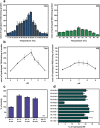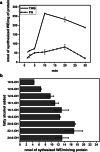Lipases of germinating jojoba seeds efficiently hydrolyze triacylglycerols and wax esters and display wax ester-synthesizing activity
- PMID: 33468064
- PMCID: PMC7814598
- DOI: 10.1186/s12870-020-02823-4
Lipases of germinating jojoba seeds efficiently hydrolyze triacylglycerols and wax esters and display wax ester-synthesizing activity
Abstract
Background: Simmondsia chinensis (jojoba) is the only plant known to store wax esters instead of triacylglycerols in its seeds. Wax esters are composed of very-long-chain monounsaturated fatty acids and fatty alcohols and constitute up to 60% of the jojoba seed weight. During jojoba germination, the first step of wax ester mobilization is catalyzed by lipases. To date, none of the jojoba lipase-encoding genes have been cloned and characterized. In this study, we monitored mobilization of storage reserves during germination of jojoba seeds and performed detailed characterization of the jojoba lipases using microsomal fractions isolated from germinating seeds.
Results: During 26 days of germination, we observed a 60-70% decrease in wax ester content in the seeds, which was accompanied by the reduction of oleosin amounts and increase in glucose content. The activity of jojoba lipases in the seed microsomal fractions increased in the first 50 days of germination. The enzymes showed higher activity towards triacylglycerols than towards wax esters. The maximum lipase activity was observed at 60 °C and pH around 7 for triacylglycerols and 6.5-8 for wax esters. The enzyme efficiently hydrolyzed various wax esters containing saturated and unsaturated acyl and alcohol moieties. We also demonstrated that jojoba lipases possess wax ester-synthesizing activity when free fatty alcohols and different acyl donors, including triacylglycerols and free fatty acids, are used as substrates. For esterification reactions, the enzyme utilized both saturated and unsaturated fatty alcohols, with the preference towards long chain and very long chain compounds.
Conclusions: In in vitro assays, jojoba lipases catalyzed hydrolysis of triacylglycerols and different wax esters in a broad range of temperatures. In addition, the enzymes had the ability to synthesize wax esters in the backward reaction. Our data suggest that jojoba lipases may be more similar to other plant lipases than previously assumed.
Keywords: Jojoba; Lipase; Simmondsia chinensis; Triacylglycerols; Wax ester hydrolase; Wax ester synthesis; Wax esters.
Conflict of interest statement
The authors declare that they have no competing interests.
Figures






Similar articles
-
The production of wax esters in transgenic plants: towards a sustainable source of bio-lubricants.J Exp Bot. 2022 May 13;73(9):2817-2834. doi: 10.1093/jxb/erac046. J Exp Bot. 2022. PMID: 35560197 Free PMC article. Review.
-
Molecular characterization of the fatty alcohol oxidation pathway for wax-ester mobilization in germinated jojoba seeds.Plant Physiol. 2013 Jan;161(1):72-80. doi: 10.1104/pp.112.208264. Epub 2012 Nov 19. Plant Physiol. 2013. PMID: 23166353 Free PMC article.
-
Wax ester-synthesizing activity of lipases.Lipids. 1999 Nov;34(11):1159-66. doi: 10.1007/s11745-999-0467-4. Lipids. 1999. PMID: 10606038
-
High-yield preparation of wax esters via lipase-catalyzed esterification using fatty acids and alcohols from crambe and camelina oils.J Agric Food Chem. 2001 Feb;49(2):647-51. doi: 10.1021/jf000852i. J Agric Food Chem. 2001. PMID: 11262006
-
Storage oil hydrolysis during early seedling growth.Plant Physiol Biochem. 2009 Jun;47(6):485-90. doi: 10.1016/j.plaphy.2008.12.005. Epub 2008 Dec 16. Plant Physiol Biochem. 2009. PMID: 19136267 Review.
Cited by
-
Elevated nitrogen fertilization differentially affects jojoba wax phytochemicals, fatty acids and fatty alcohols.Front Plant Sci. 2024 Jul 25;15:1425733. doi: 10.3389/fpls.2024.1425733. eCollection 2024. Front Plant Sci. 2024. PMID: 39129760 Free PMC article.
-
Characterization of a novel subfamily 1.4 lipase from Bacillus licheniformis IBRL-CHS2: Cloning and expression optimization.PLoS One. 2024 Dec 17;19(12):e0314556. doi: 10.1371/journal.pone.0314556. eCollection 2024. PLoS One. 2024. PMID: 39689112 Free PMC article.
-
Exogenous melatonin promoted seed hypocotyl germination of Paeonia ostia 'Fengdan' characterized by regulating hormones and starches.PeerJ. 2024 Sep 20;12:e18038. doi: 10.7717/peerj.18038. eCollection 2024. PeerJ. 2024. PMID: 39314842 Free PMC article.
-
The production of wax esters in transgenic plants: towards a sustainable source of bio-lubricants.J Exp Bot. 2022 May 13;73(9):2817-2834. doi: 10.1093/jxb/erac046. J Exp Bot. 2022. PMID: 35560197 Free PMC article. Review.
-
Effect of germination pretreatment on the physicochemical properties and lipid concomitants of flaxseed oil.RSC Adv. 2023 Jan 23;13(5):3306-3316. doi: 10.1039/d2ra07458c. eCollection 2023 Jan 18. RSC Adv. 2023. PMID: 36756417 Free PMC article.
References
-
- Miwa TK. Jojoba oil wax esters and derived fatty acids and alcohols: Gas chromatographic analyses. J Am Oil Chem Soc. 1971;48:259–264. doi: 10.1007/BF02638458. - DOI
-
- Benzioni A, Van Boven M, Ramamoorthy S, Mills D. Dynamics of fruit growth, accumulation of wax esters, simmondsins, proteins and carbohydrates in jojoba. Ind Crops Prod. 2007;26:337–344. doi: 10.1016/j.indcrop.2007.04.004. - DOI
MeSH terms
Substances
Grants and funding
LinkOut - more resources
Full Text Sources
Other Literature Sources

